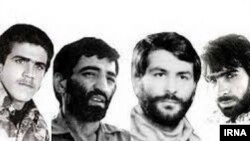The Director of the Islamic Revolution Guards Corps, IRGC-affiliated Owj Media Organization has published a statement insisting that four Iranian government employees abducted, in northern Lebanon in 1982, were killed on the spot.
Meanwhile, "commemorating the name and memory of the abducted diplomats," Iranian Ministry of Foreign Affairs announced on Friday, July 3, "Some evidence shows that Iranian diplomats, abducted in Lebanon, have been handed over to the Zionist (Israeli) regime and subsequently transferred to the occupied lands and territories."
Although there is information about the burial place of the four Iranians, and several groups including an Iranian documentary film crew have seen the evidence of the four men's killing in northern Lebanon, the Ministry has stressed that it will continue efforts to determine the fate of abducted Iranians it claims are behind bars in Israel.
According to Iranian government officials and media, a military attaché at Tehran's embassy in Beirut, Ahmad Motovasselian, along with Iranian chargé d'affaires in Lebanon, Mohsen Mousavi, an employee of the embassy, Taqi Rastegar Moqaddam, and a photographer for the Islamic Republic News Agency (IRNA), Kazem Akhavan, were abducted on July 4, 1982.
Kataeb Party (also called Phalange), a predominantly Christian Lebanese right-wing party, is responsible for the abduction, Iranian officials have repeatedly maintained.
Since then, there has been no official information about their fate.
Nonetheless, on Friday, July 3, the state-run Mehr News Agency (MNA) published a note signed by the Director-General of the IRGC-linked Owj Arts and Media Organization, Ehsan Mohammad Hassani, claiming that the four were "kidnapped" on the Mediterranean coast by "Lebanese forces" loyal to the executive chairman of the Lebanese Forces at the time, Samir Geagea.
After being kidnapped, the four were killed by a firing squad under Geagea's control, Mohammad Hassani asserted in his note, adding that the four's burial site is known.
At the same time, Mohammad Hassani called the IRGC's extraterritorial arm, the Qods Force, to cooperate with the Islamic Republic Foreign Ministry and search the burial place.
In another part of his note, Mohammad Hassani says, "presuming that the four are still alive," might have "benefits" for "profit-seeking pragmatic faction." This is a veiled reference perhaps to some in Iran’s foreign ministry who still insist the kidnapped people are alive and justify a lot of activities promising to free them from Israeli detention.
Nevertheless, on May 23, 2016, the Islamic Republic Minister of Defense at the time, IRGC Brigadier General Hossein Dehqan (Dehghan), officially announced that the four were "alive" and in captivity in Israel.
At the same time, the then Deputy Chairman of the influential National Security Commission of Majles (the Iranian parliament), AbolFazl Hassan Baighi, also declared that one of the four abducted Iranians, Ahmad Motovasselian, was "certainly" alive until 2008.
In Lebanon, the Iranian embassy had also announced in 2008 that the four were still "alive" behind bars in Israel.
However, Israel has repeatedly asserted that "the four Iranians were most likely killed by the "Lebanese Christian Phalange" loyal to Samir Geagea.
Therefore, the recent note written by the head of Owj Organization is somehow confirming Israelis' claim. The interesting issue is that Owj would not have dared to say anything if a faction in Iran did not want to bring the case to a closure.
Nevertheless, without any reference to the death of the four, the Iranian Foreign Ministry called on Friday to form a Red Cross probe committee to investigate the case.
Despite the Foreign Ministry's insistence that the four are still alive, their death has been highlighted on social media.
A controversial documentary filmmaker, Hossein Dehbashi, said in a tweet that the four were killed on July 5, 1982, and that it was expedient to "declare them alive in conjunction with the fate of a kidnapped Israeli co-pilot, Ron Arad."
"The news of the martyrdom of Ahmad Motovasselian has just been made public," Dehbashi tweeted, adding, "Many, including Hamid Davoodabadi and me, and more than us, Iran's former ambassador to Syria, Mr. Akhtari, as well as others, already knew the exact location of his martyrdom and burial place in Berbara. But, whenever we decided to mention his death, they silenced us!"
The Israeli government tried to find them for years and attempted to deal with the Lebanese Shi'ite militias and Hezbollah over Arad's release.
Earlier, some media outlets speculated that if Ron Arad was handed over, the fate of the four abducted Iranians might also be determined.
However, in September 2016, Israeli media reported that after Western mediators and Israel's joint efforts with Iran and Hezbollah in Lebanon confirmed Ron Arad's death, Christian Phalange under the command of Samir Geagea killed and buried the four Iranians.
Therefore, Israel closed Ron Arad's case and stopped its efforts to find him. However, despite the closure of Arad's case in Israel, the case of the four abducted Iranians is still open in Iran, and speculations abound.





